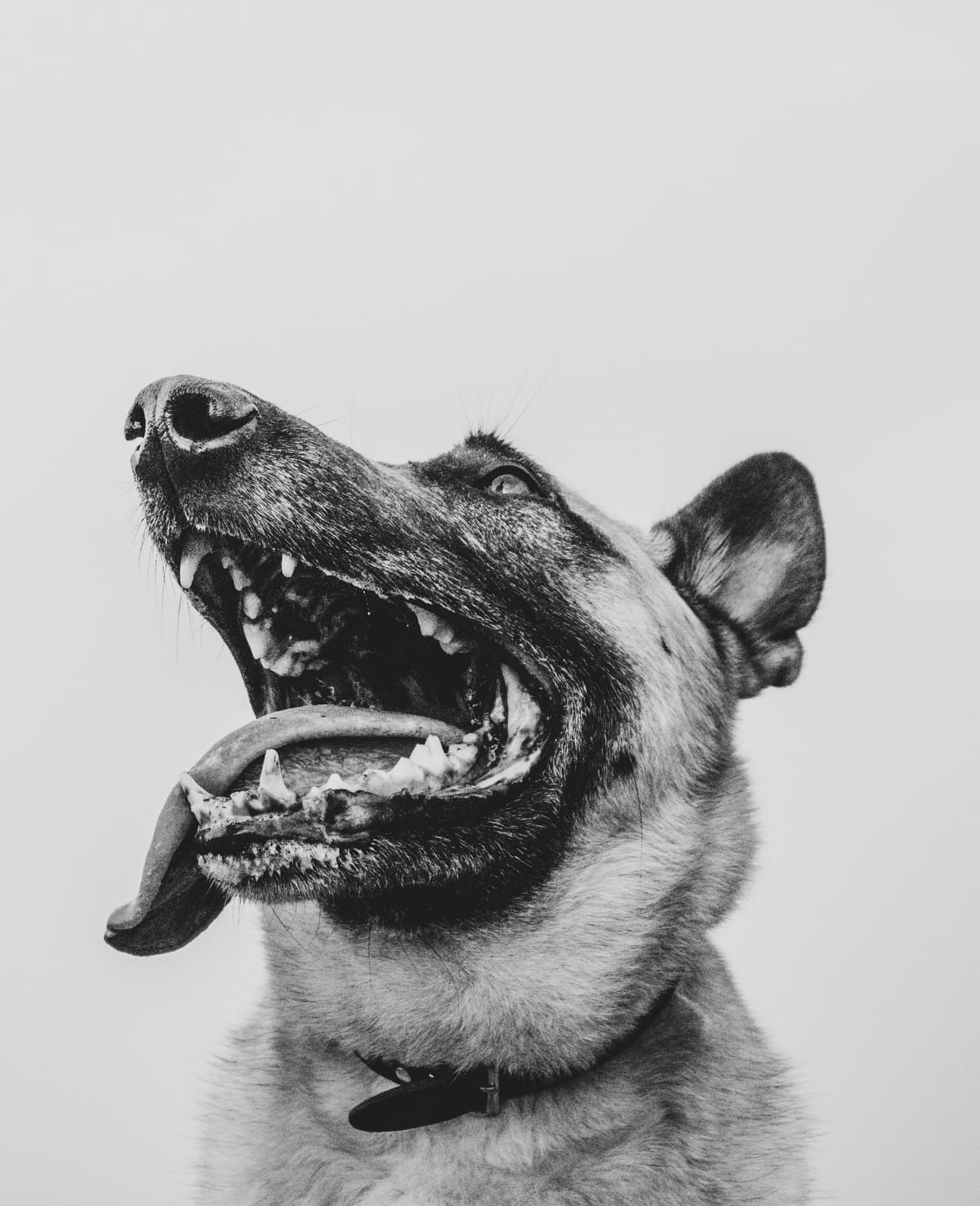Understanding the police, military or prison dog as a form of legal terror. Many people of colour carry fear/trauma relating to a dog: why is that?
by Nasra Hussen
Black people are scared of dogs; this is a stereotype as well as a very pervasive truth. In fact it goes beyond Africans and includes groups such as Arabs and some south Asian communities. For many of these groups there is a cultural dimension to this discussion; dogs, much like pigs, are seen as being dirty. Therefore, they should be interacted with minimally. In other cultures dogs are simply animals that perform a function (e.g. guard dogs) so affectionate relationships with them are rare. And they certainly don’t live inside the home. A lot of black people explain having an aversion to dogs that cannot be put into words; perhaps it is an amalgamation of all of these reasons.
But these are digressions. At the core, there are very important socio-historic considerations to be made within this topic.
The use of dogs as weaponry has long been a feature of colonial aggression. This can be traced from the time Columbus and the Spanish colonists brought their ‘war-dogs’ or ‘dogs of war’ onto the Americas to be used for battle and repression. These dogs were trained to viciously attack and kill indigenous peoples.

It is well documented that dogs continued to be used to intimidate, interrogate and stalk native peoples throughout colonised lands, including African countries and Australia. In the Americas they were used against slave populations, namely to threaten, humiliate or maim as well as to track down escapees. During this time dogs were trained to repeatedly attack “a figure roughly formed as a Negro in wicker work” – these figures would be stuffed with animal entrails and be doused in blood.
“Police dogs were invented by slavers. Now they’re used by cops.” *
Dogs were a part of the mobs during lynchings. They were used to tear victims apart or as a means of capture. In fact, the use of police dogs never became so widespread and institutionalized as it was during the civil rights era. They were used in prisons, plantations, on the streets – creating an echoing terror that has haunted generations.
In South Africa, the government imported European dogs at great cost to be trained by a Dutch settler named Cornelius Kuyper. These dogs were trained to aid the police force and were particularly admired for their sense of smell, which made tracking and stalking more feasible. Historian Sandra Swart argued that the Clever Hans effect was more than likely a large factor within the relationship between dog and handler. The Clever Hans effect is a psychological term used to describe when an animal or person senses what someone wants them to do, despite not being given any overt signals. This triggers a certain reaction or response.
The training and reactions of the dogs soon shifted from detection to attacking. Discussing the switch in tactics, Swart said that “it was about performing power, patrolling race, cementing the insistence on a biological basis for difference and deference.” The fact that dogs are acutely aware of the distinction between races is echoed by scholar Tyler Wall, a researcher in police and racialized violence: “The mystical power of the police dog […] was its apparent ability to recognize the boundaries dividing those bodies in need of protection – white propertied bodies –from those darker bodies prowling on the boundaries of white bourgeois order.” Further, Wall suggests that K-9 Units were introduced “to civilize the savagery of urban (dis)order and pacify urban space.”
Throughout the 20th century, dogs were used to apprehend gangs, as well as crowd control, including protests and demonstrations. Throughout the world, the police dog – and, generally, the figure of a dog – is emblematic of racist state violence. Interestingly, there was a distinction between the colonial dog and the native dog in both the minds of the Colonialists and the Natives. Colonial dogs were bred, trained and employed to be used to keep Native populations away from white settlements. These animals were trained specifically to see non-white people as transgressors and to attack in the name of protecting white populations and property.
From Slavery and Jim Crow to the military dogs at Guantanamo and Abu Ghraib, there is nothing to suggest that the use of dogs for terror is a thing of the past. Contemporarily, these tactics were seen during many of the Black Lives Matter protests, most notably during those following the killing of Michael Brown in 2014. In Abu Ghraib, soldiers made a game of using dogs to frighten inmates until they urinated or defecated. The prison held teenagers who were also tortured in this way. An Abu Ghraib interrogator testified that soldiers were told to command dogs to bark within a foot of the children. The use of this canine torture, although internationally condemned, appears to have been imported into the United States.
A report published in 2005 showed that the men who were responsible for the building of the prison and the training of the soldiers as well as overseeing operations had all been high level state prison administrators and commissioners prior to their involvement at Abu Ghraib.
In prisons across the US, these officials administered programs that encouraged the use of dogs to intimidate and attack incarcerated people. Today, these programs continue on. Statistics show that, over the last six years, hundreds of incarcerated people have been attacked by dogs and have suffered varying degrees of injury.
In the US, cases of police dogs attacking civilians, particularly African Americans, is common. A recent case involves a motorist who was stopped due to a missing mudflap. The man in question, who had his arms raised and was compliant, had a police dog released on him resulting in a vicious attack. This case has thrown the use of police dogs into mainstream discourse. Organizations such as The Marshall Project work to trace police dog attacks across the US hoping to pave the way for justice for the individuals as well as hope for reform.
In the UK, the situation isn’t very different. The UK also has a history of police dog attacks on minorities, particularly those of African descent. Traditionally, British police dogs were trained to protect the uniform and to attack anyone who wasn’t in uniform. In fact, the dogs would snarl at their own handlers if they were out of uniform. Presently, UK police do not have any legal restrictions regulating the use of sniffer dogs. They only have guidelines which suggest that they cannot force anyone to walk past or interact with sniffer dogs. However, people are funnelled past police sniffer dogs through airports, train stations etc. as a manner of bypassing their own guidelines. Moreover, the police take the avoidance of sniffer dogs as reasonable grounds for a search; they will also take a dog’s indication (as well as behavior they interpret to be a dog’s indication) to be grounds for a search. There is a serious risk of injury present if someone should resist a search conducted in this manner.
Attacks by police dogs are pervasive in Africa as well. There they are used, as in the US and UK, as a manner of crowd control, interrogation and intimidation. Here too they are trained to attack protesters and gang members and anyone deemed to be a criminal. However, there are numerous cases of police encouraging dogs to chase and maul victims where there is no physical threat and where no crime has been committed. In 2000, an internationally renowned police dog trainer, Hans Schegel, said that 90% of the dogs used by the South African police force should be put down. Schegel states that “the dogs are trained on fear” and that “they don't trust anybody and cannot socialize with other dogs or people and are kept in cages after hours.” These conditions create a particularly vicious animal who is then used to apprehend members of the public. Schegel made these comments after seeing footage of police dogs being used to attack immigrants coming into South Africa – a practice that is currently used against immigrants coming into Europe and the US. In South Africa, at the time, setting dogs to attack immigrants was a part of their training programme.
‘Dogs of war’ was a term used by colonial forces in the Americas in the past. Today the term is used by Palestinians to refer to the dogs the IDF routinely use to instill terror. Much more insidious however is the use of dogs by illegal settlers. Their compounds are gated as heavily as any military outpost and the dogs serve as an early warning system. They signal that Israelis should grab their guns.

Many settlers with a reasonable income have their dogs trained by programs that teach them to defend them from Arabs “insurgents.” One such program boasts being able to train dogs to smell the difference between Jewish settlers and Arab “terrorists.” Settlers with a more modest income opt for a much more crude manner of “training” their dogs; impoverished Palestinians are given a small fee to savagely beat their dogs, therefore ensuring that the dog remains fearful and vigilant against outsiders (i.e. Palestinians). This guarantees a vicious greeting to any future Palestinians the dog may encounter.
These methods and programs provide training to dogs that defend illegal settlements in the West Bank. With the number of illegal settlers in this region increasing, so too does their paranoia. This has resulted in a recent spike in the amount of “trained” dogs. More dogs have meant more attacks. They have increased in both frequency and in viciousness. Palestinian children as young as five carry lifelong injuries gained at the hands of these dogs. There is also evidence to show that these dogs are used offensively as well, with IDF soldiers and Israeli police both being amidst accusations of encouraging or conducting dog attacks.
The Israeli settler dog has all the characteristics of the dogs employed during the civil rights era and of the colonialist’s dogs in the old Americas. These histories compound as culturally ingrained caution and fear.
Most fear is learned or is due to direct negative experience. If your parents fear spiders, then you too are very likely to carry the same fear. Moreover, if your parents fear spiders it is likely their parents were the source of that fear and their parents before them. At some point in that chain of caution is a trauma that initially instilled the fear of spiders into an ancestor of yours. There is science that suggests that this is one of the ways that phobias manifest. (1, 2)
In epigenetics, the study of heritable changes in gene expression that affect how cells read genes, it is shown that fears that aren't directly learned or experienced can have been inherited. Studies show that fear can change the way your body reads genes, without actually changing DNA, over generations. It also shows that certain fears, especially those related to terror, anxiety and PTSD inducing events, are passed down to offspring. This creates intergenerational ripples, both learned and inherited, across communities.
It must also be stated that the opposite is also very true. That is to say that the dog's handler/owner is also an integral part of this equation. A feature of racism and the colonial mentality is to induce fear of the victim. If the socio-political climate induces a fear of a certain category of person, what must be acknowledged is the simple fact that dogs instinctively react to the stresses and fears of their owners. If a person feels fearful of a person, the dog is likely to attack in defense. If this is reinforced by its owner feeling constantly fearful around a certain group of people, the dog will associate the whole demographic with danger and will act accordingly.
Consider the police officers who shoot before asking questions. They do so, in equal measure, due to fear and a dehumanization of the subject. It is an offensive and defensive act; a self-fulfilling dynamic. Like the Ouroboros, constantly feeding on itself in order to nourish itself.
Dogs, in any context, serve as a clear and violent reflection of human emotions and prejudices. A proxy that enacts terror in our stead.
Nasra Hussen is a writer, artist, and a member of the Interregnum collective.






Comments ()